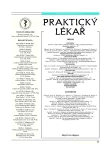The anxious patient with cardiovascular symptomatology
Úzkostný pacient s kardiovaskulárními příznaky
Autoři předkládají přehled zaměřený na typické kardiovaskulární příznaky, na něž si stěžují pacienti, jejichž základním onemocněním je úzkostná porucha. Upozorňují na vztahy některých emocí, zejména úzkosti, deprese a hněvu, ke kardiovaskulární symptomatologii. Více než třetina pacientů s nestabilní anginou pectoris či po proběhlém infarktu myokardu si stěžuje na úzkost a tato úzkost přetrvává u poloviny z nich po dobu nejméně jednoho roku. Na druhé straně psychosociální stres a úzkost vyvolávají nežádoucí změny autonomních regulačních systémů a stávají se tak vážnými kardiovaskulárními riziky, jejichž vlivy je možné a žádoucí usměrňovat. Častým problémem je rovněž komorbidita úzkostných poruch a kardiovaskulárních onemocnění, zejména ICHS, arytmií i náhlé srdeční smrti.
V článku jsou popsány faktory ovlivňující charakteristiky bolestí na hrudi, a to jak u nemocných s kardiálním onemocněním, tak u pacientů s úzkostnými poruchami a dále jsou nabídnuty algoritmy diagnostických a terapeutických postupů uspořádané tak, aby jednak minimalizovaly riziko přehlédnutí kardiálního onemocnění, ale současně zabránily nadhodnocení tohoto rizika, které ve svých důsledcích v praxi vede ke zvyšování úzkosti a posilování hypochondrických postojů úzkostných pacientů.
Klíčová slova:
úzkost – úzkostné poruchy – bolest na hrudi – diagnóza – léčba – kardiální onemocnění – funkční poruchy.
Authors:
R. Honzák 1,2; B. Seifert 2
Authors‘ workplace:
Psychiatrická katedra IPVZ, Praha
vedoucí prof. MUDr. K. Chromý, CSc.
1; Ústav všeobecného lékařství 1. LF UK, Praha
přednosta MUDr. B. Seifert
2
Published in:
Prakt. Lék. 2005; 85(2): 102-106
Category:
General Medicine
Overview
The authors submit a review of typical chest symptoms of patients suffering from anxious disorders. The relationship of our emotion – especially of anxiety, depression, and anger – to heart activity is intriguing. Over one third of patients with unstable angina and after myocardial infarction experienced elevated anxiety at the time of the ischemic event, and these symptoms persisted for 1 year in 50% of anxious patients. On the other hand psychosocial stress and anxiety induce adverse changes in autonomic tone accounting for substantial but modifiable cardiovascular risk. There is also frequent commorbidity of anxious disorders and coronary heart disease, arrhytmias and sudden cardiac death.
The authors describe factors influencing chest pain expression in patients with cardiac or anxious disease and offer the useful algorhitm of diagnostic and therapeutic methods which minimize the risk of omission (neglect some serious cardiac problems), as well as commission (worsening of anxious and hypochondrical attitudes of these patients).
Key words:
anxiety – anxiety disorders – chest pain – diagnosis – treatment – cardiac disease – noncardiac disease – MUS.
Labels
General practitioner for children and adolescents General practitioner for adultsArticle was published in
General Practitioner

2005 Issue 2
- Memantine Eases Daily Life for Patients and Caregivers
- Metamizole at a Glance and in Practice – Effective Non-Opioid Analgesic for All Ages
- Metamizole vs. Tramadol in Postoperative Analgesia
- Memantine in Dementia Therapy – Current Findings and Possible Future Applications
- What Effect Can Be Expected from Limosilactobacillus reuteri in Mucositis and Peri-Implantitis?
Most read in this issue
- Brachyspirae – agents of intestinal spirochetosis
- The diabetic foot and hyperbaric oxygen therapy
- Treatment of traumatic lesions of the brachial plexus
- Inborn anomalies of the coronary arteries: three case reports
